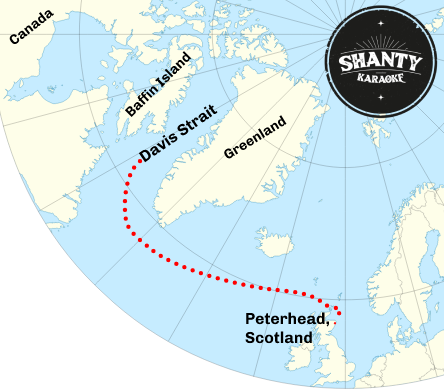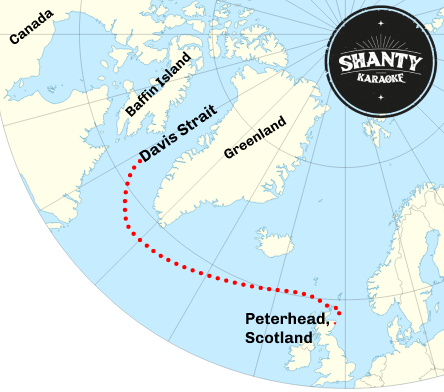This iconic shanty celebrates the whaling ship The Diamond. It talks of the emotional send-off and the anticipated return with riches. Unfortunately, the ship never made it back. It was lost at sea along with several other ships.
We’re going to dig into the history of the ship, break down the lyrics, and share our favourite versions of the shanty. If you’re familiar with the tune and fancy singing it, check out our instrumental karaoke version of The Bonny Ship The Diamond.
History of The Bonny Ship The Diamond
There are several narratives around this ship and insufficient evidence to decide which is true. The disparities among them could mean a few different things. It’s possible there were separate whalers called The Diamond.
It’s equally likely that events have been embellished, dates changed, and facts skewed to make a better tale. And if you’ve ever met a fisherman, you’ll know they’re fond of a good tale.
The whaling voyage spoke about in the song launches from the port of Peterhead in Scotland – Peterheid to the locals. The hunt would take them to the cold arctic weather of the Davis Strait. The Davis Strait is the body of water between Greenland and the Canadian Baffin Island.

Version #1
The first narrative is largely taken from A.L. Lloyd‘s notes on Leviathan. He claims the song must originate sometime between 1825 and 1830. Why? The Diamonds first voyage as a whaler was in 1825 and it accurately refers to historical events but doesn’t mention The Diamond was lost in 1830.
Favourable winds allowed them and the rest of the fleet to reach the hunting grounds earlier than anticipated. They ventured further north into Melville Bay in search of whales. However, these winds turned out to be their ruin. Lots of ice floes – huge collections of floating ice – were also blown in.
The ships were trapped. They couldn’t escape because of the ice. Lloyd claims that twenty of the ships were crushed by the encroaching ice. Including the ships named in our song: “The Diamond, the Resolution, the Rattler (not Battler) of Leith (not Montrose), and the Eliza Swan.”
As you can imagine, many whalermen would have died. According to Scots Language, the whalermen were prepared for this and had “put tree trunks inside across the hulls to make the ships stronger.” When it became clear the ships were not going to be saved, the sailors escaped onto the ice. “They lived in tents made from the sails and burnt their ships’ timbers for warmth.”
Scots Language claims the sailors of The Diamond were eventually rescued and returned home. Lloyd’s words suggest they were lost: “The Eliza Swan was among those that got free and brought the sad news home.”
Peter Hall tells broadly the same story but has different dates. “She was commissioned in Quebec in 1801 and ended her days crushed by the ice in 1819.” Hall claims the men crossed directly to another ship and were saved.
Version #2
The other possible narrative also has origins in Quebec. Wikipedia claims she was commissioned in 1798, then did two trips as a slaver before being repurposed as a British whaler in 1804. It’s not unreasonable to assume this could be the ship Peter Hall was referencing, as it’s only a few years apart.
This Diamond was captured by a French privateer in 1805. The British sailors were taken prisoner and eventually shipped to Saint Helena. The French renamed her Diamant and used her as a merchant ship. She continued like this until being decommissioned after a bad storm in 1809. But this doesn’t make for such an engaging tale.
The truth
What’s the true account? I suspect there may have been two whalers with the same name – there’s evidence supporting both theories. Have some facts and dates been muddled? Almost certainly. Look at any folk song and you’ll see the lyrics evolve as time passes.
It’s safe to assume The Diamond was a real whaler, it sailed to the Davis Strait, and was likely trapped in the ice. Exactly what happened to its crew remains somewhat up for debate.
The Bonny Ship The Diamond lyrics
The Diamond is a ship, my lads, for the Davis Strait she’s bound
And the quay it is all garnished with bonnie lasses ’round
Captain Thompson gives the order to sail the ocean wide
Where the sun it never sets, my lads, no darkness dims the sky
(Chorus)
For it’s cheer up my lads, let your hearts never fail
For the bonny ship, The Diamond, goes a-fishing for the whale
For it’s cheer up my lads, let your hearts never fail
For the bonny ship, The Diamond, goes a-fishing for the whale
Along the quay at Peterhead, the lasses stand around
Wi’ their shawls all pulled around them and the salt tears runnin’ down
Don’t you weep, my bonnie lass, though you be left behind
For the rose will grow on Greenland’s ice before we change our mind.
(Chorus)
Here’s a health to the Resolution, likewise the Eliza Swan,
Here’s a health to the Battler of Montrose and the Diamond, ship of fame
We wear the trousers o’ the white and the jackets o’ the blue
When we return to Peterhead, we’ll have sweethearts anew
(Chorus)
It will be bright both day and night when the Greenland lads come hame,
With a ship that’s full of oil, my lads, and money to our name
We’ll make the cradles for to rock and the blankets for to tear
And every lass in Peterhead sing “Hushabye, my dear”
(Chorus) x3
What the lyrics mean
We’ll now look at any specialist vocabulary and phrases you might not be familiar with. But before doing that, we want to share a fun fact.
Similar lyrics show up in the 1851 novel Moby Dick by Herman Melville. He likely learned the song during his whaling years. It supports our earlier point about how song lyrics evolve:
So be cheery my lads! Let your hearts never fail
While the bold harpooner is striking the whale!
“And the quay it is all garnished with bonnie lasses ’round”
The quay is a long platform beside the water that allows easy access to the ship for loading and unloading. In Peterhead, the whalers would unload at Blubber Box Quay. It’s now used by fishing boats.
‘Bonnie lasses’ is the Scottish way of saying pretty ladies. As an aside, we’ve used the common Scottish spelling ‘Bonnie’ here, but have kept ‘Bonny’ when describing the ship because it’s become the accepted norm.
So… lots of pretty ladies came to stand alongside the ship and say goodbye to their men.
“Where the sun it never sets, my lads, no darkness dims the sky”
This is referencing the arctic seasons. In the summer months, the sun will never fully set and there will always be light in the sky. This phenomenon is known as the midnight sun.
“Here’s a health to the Resolution, likewise the Eliza Swan”
This is a toast wishing the good health and safety of the named ships. Unfortunately, as you now know, many of these ships were caught in the ice and lost.
It’s possibly also a reference to the popular song “Health to the Company”.
Best versions of The Bonny Ship The Diamond
These are a few of our favourites:
The Longest Johns
This is a more modern version of the song and adds some flourishes not seen in other versions.
David Coffin
If you’re looking for a powerful version that sounds ‘authentic’, then look no further. The traditional elements make it very appealing. He also uses alternate lyrics that aren’t as popular today.
Beoga
This version is by an Irish band with a female lead. A very different take on the song, but a fantastic version that few people have heard of. Take the time and have a listen.
Final thoughts
The Bonny Ship The Diamond is no longer a mystery to you. You understand the locations mentioned, the history of the ship, and have heard a few great versions. If we missed anything, let us know in the comments.
If you’d like to try singing it, why not give our acoustic karaoke version a go?


Looking at the online British Newspaper Archive, The Aberdeen Journal, 18/3/1812 states “The fine new ship Diamond, Gibbon, [ie captain of the ship] sailed on Thursday last for the Davis Straits whale fishery.”
The Durham County Advertiser, 16/8/1817 has Diamond, Thompson, arriving at Aberdeen from Greenland and Davis Strait whale fisheries. The same article has Resolution arriving at Peterhead and Eliza Swan at Montrose
Some versions of the song give the captain’s name as Gibbons (eg John Ord, bothy songs and Ballads, 1930), others Thompson as you have it here. So this is surely the right ship, and means that AL Lloyd’s version is too late, and the Quebec ship was too early!
Hi Rod, that’s some impressive detective work! It all gets very confusing when discussing the origins of shanties. Thank you for taking the time to share.
You’re right, that version by Beoga is quite good! Thanks for introducing me to them.
Blowzabella also do a fine version.
https://www.youtube.com/watch?v=v3a_cYG43yU
That’s great. I love that I keep discovering more hidden gems. Cheers!
As I am a huge Judy Collins fan, I am particularly of her rendition.